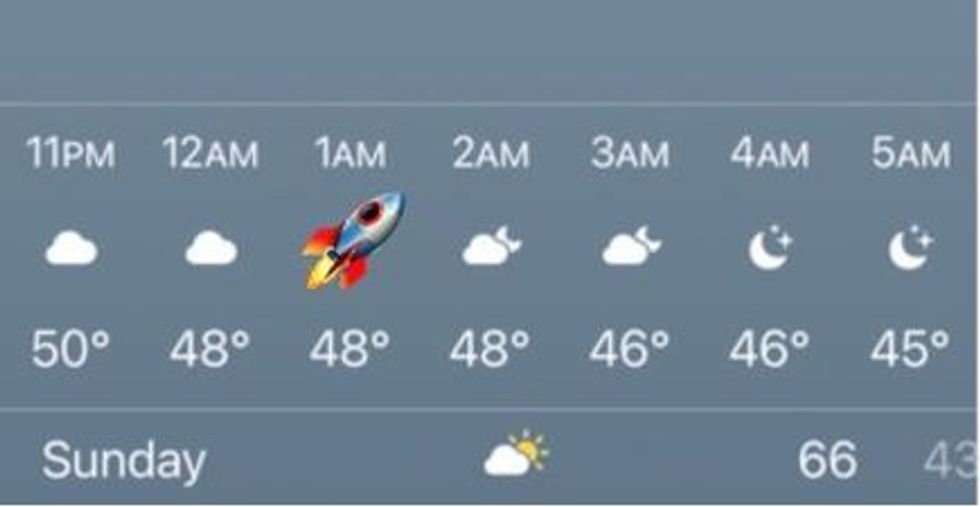

SUBSCRIBE TO OUR FREE NEWSLETTER
Daily news & progressive opinion—funded by the people, not the corporations—delivered straight to your inbox.
5
#000000
#FFFFFF
To donate by check, phone, or other method, see our More Ways to Give page.


Daily news & progressive opinion—funded by the people, not the corporations—delivered straight to your inbox.
What else would you expect these convulsive days. This weekend, a massive out-of-control Chinese rocket is hurtling back to Earth while much of the world wonders, with a mix of anxiety and sheesh-what-next resignation, just where it will land and if they'll be under it. Amidst the apocalyptic bingo card gags and forecasts - Partly cloudy with a chance of rocket - many have proposed, in the name of karma, the perfect, poetic landing site. Oh please.

Because really what else would you expect these convulsive days, a massive Chinese rocket is hurtling uncontrolled back down to Earth this weekend while much of the world wonders, with a mix of actual anxiety and sheesh-what-next resignation, just where it will land and if they'll be under it when it does. Part of a new Chinese space station that went into orbit on April 29 but was then left to hurtle through space, the 23-ton, 100-foot Long March 5B rocket booster was expected to enter Earth's atmosphere from late Saturday night to early Monday morning. It's predicted to land in a laughably broad "risk zone" that encompasses much of the world - all the Americas south of New York, all of Africa and Australia, large swaths of Asia and Europe - thanks to its speed of 18,000 miles an hour, which means you'll know where it lands when it lands but it'll probably be in an ocean because that's most of the Earth's surface. One astrophysicist called the risk of it hitting you "incredibly tiny - I would not lose one second of sleep over this on a personal threat basis," but if the last few years have made you feel you'll never know what's coming down the pike, you can get updates here and here.



Trump and Musk are on an unconstitutional rampage, aiming for virtually every corner of the federal government. These two right-wing billionaires are targeting nurses, scientists, teachers, daycare providers, judges, veterans, air traffic controllers, and nuclear safety inspectors. No one is safe. The food stamps program, Social Security, Medicare, and Medicaid are next. It’s an unprecedented disaster and a five-alarm fire, but there will be a reckoning. The people did not vote for this. The American people do not want this dystopian hellscape that hides behind claims of “efficiency.” Still, in reality, it is all a giveaway to corporate interests and the libertarian dreams of far-right oligarchs like Musk. Common Dreams is playing a vital role by reporting day and night on this orgy of corruption and greed, as well as what everyday people can do to organize and fight back. As a people-powered nonprofit news outlet, we cover issues the corporate media never will, but we can only continue with our readers’ support. |

Because really what else would you expect these convulsive days, a massive Chinese rocket is hurtling uncontrolled back down to Earth this weekend while much of the world wonders, with a mix of actual anxiety and sheesh-what-next resignation, just where it will land and if they'll be under it when it does. Part of a new Chinese space station that went into orbit on April 29 but was then left to hurtle through space, the 23-ton, 100-foot Long March 5B rocket booster was expected to enter Earth's atmosphere from late Saturday night to early Monday morning. It's predicted to land in a laughably broad "risk zone" that encompasses much of the world - all the Americas south of New York, all of Africa and Australia, large swaths of Asia and Europe - thanks to its speed of 18,000 miles an hour, which means you'll know where it lands when it lands but it'll probably be in an ocean because that's most of the Earth's surface. One astrophysicist called the risk of it hitting you "incredibly tiny - I would not lose one second of sleep over this on a personal threat basis," but if the last few years have made you feel you'll never know what's coming down the pike, you can get updates here and here.




Because really what else would you expect these convulsive days, a massive Chinese rocket is hurtling uncontrolled back down to Earth this weekend while much of the world wonders, with a mix of actual anxiety and sheesh-what-next resignation, just where it will land and if they'll be under it when it does. Part of a new Chinese space station that went into orbit on April 29 but was then left to hurtle through space, the 23-ton, 100-foot Long March 5B rocket booster was expected to enter Earth's atmosphere from late Saturday night to early Monday morning. It's predicted to land in a laughably broad "risk zone" that encompasses much of the world - all the Americas south of New York, all of Africa and Australia, large swaths of Asia and Europe - thanks to its speed of 18,000 miles an hour, which means you'll know where it lands when it lands but it'll probably be in an ocean because that's most of the Earth's surface. One astrophysicist called the risk of it hitting you "incredibly tiny - I would not lose one second of sleep over this on a personal threat basis," but if the last few years have made you feel you'll never know what's coming down the pike, you can get updates here and here.


